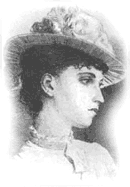Essays by Alice Meynell
By Alice Meynell

Unstable Equilibrium
It is principally for the sake of the leg that a change in the dress of man is so much to be desired. The leg, completing as it does the form of man, should make a great part of that human scenery which is at least as important as the scenery of geological structure, or the scenery of architecture, or the scenery of vegetation, but which the lovers of mountains and the preservers of ancient buildings have consented to ignore. The leg is the best part of the figure, inasmuch as it has the finest lines and therewith those slender, diminishing forms which, coming at the base of the human structure, show it to be a thing of life by its unstable equilibrium. A lifeless structure is in stable equilibrium; the body, springing, poised, upon its fine ankles and narrow feet, never stands without implying and expressing life. It is the leg that first suggested the phantasy of flight. We imagine wings to the figure that is erect upon the vital and tense legs of man; and the herald Mercury, because of his station, looks new-lighted. All this is true of the best leg, and the best leg is the man’s. That of the young child, in which the Italian schools of painting delighted, has neither movement nor supporting strength. In the case of the woman’s figure it is the foot, with its extreme proportional smallness, that gives the precious instability, the spring and balance that are so organic. But man should no longer disguise the long lines, the strong forms, in those lengths of piping or tubing that are of all garments the most stupid. Inexpressive of what they clothe as no kind of concealing drapery could ever be, they are neither implicitly nor explicitly good raiment. It is hardly possible to err by violence in denouncing them. Why, when an indifferent writer is praised for “clothing his thought,” it is to modern raiment that one’s agile fancy flies–fain of completing the metaphor!
The human scenery: yes, costume could make a crowd something other than the mass of sooty colour–dark without depth–and the multiplication of undignified forms that fill the streets, and demonstrate, and meet, and listen to the speaker. For the undistinguished are very important by their numbers. These are they who make the look of the artificial world. They are man generalized; as units they inevitably lack something of interest; all the more they have cumulative effect. It would be well if we could persuade the average man to take on a certain human dignity in the clothing of his average body. Unfortunately he will be slow to be changed. And as to the poorer part of the mass, so wretched are their national customs–and the wretchedest of them all the wearing of other men’s old raiment–that they must wait for reform until the reformed dress, which the reformers have not yet put on, shall have turned second-hand.
 Continue...
Continue...![[Buy at Amazon]](http://images.amazon.com/images/P/B000JN7D62.01.MZZZZZZZ.jpg)